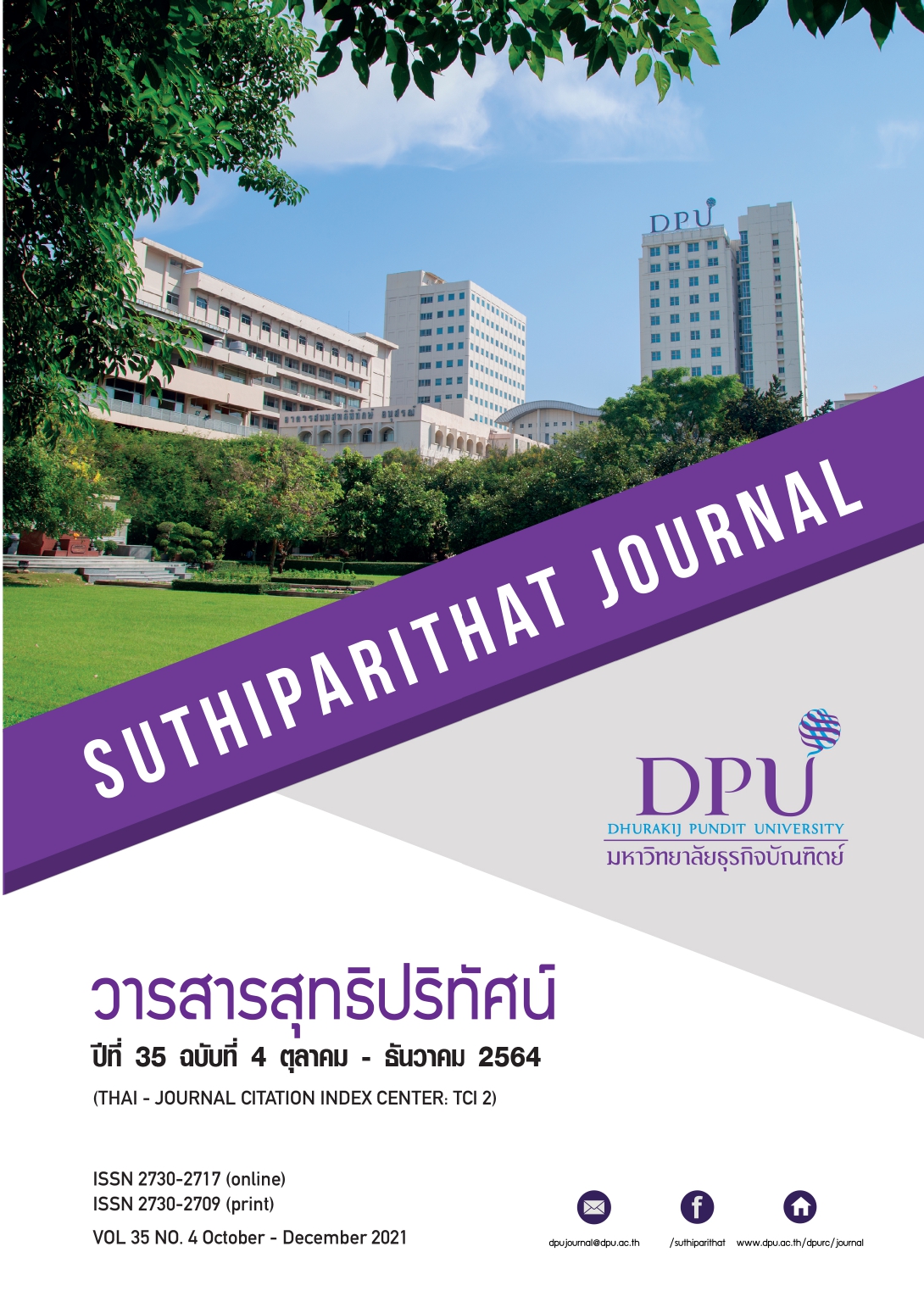การศึกษาท่อนำแสงแนวดิ่งรูปทรงสี่เหลี่ยมเพื่อการนำแสงธรรมชาติเข้าสู่ภายในอาคารประเภทที่พักอาศัยในกรุงเทพมหานคร
คำสำคัญ:
การออกแบบ, แสงธรรมชาติ, ท่อนำแสงแนวดิ่ง, การประหยัดพลังงาน, อาคารที่พักอาศัยบทคัดย่อ
จากรายงานสถิติพลังงานของประเทศไทยพบว่าตั้งแต่ปีพ.ศ. 2554-2558 มีแนวโน้มการใช้ไฟฟ้าเพิ่มขึ้น โดยอาคารบ้านพักอาศัยมีสัดส่วนการใช้ไฟฟ้ามากเป็นอันดับสาม การนำแสงธรรมชาติเข้ามาใช้ในอาคารจึงสามารถลดการใช้พลังงานไฟฟ้าได้ การศึกษาท่อนำแสงแนวดิ่งรูปทรงสี่เหลี่ยมเพื่อนำแสงธรรมชาติมาใช้ในอาคารที่พักอาศัยในกรุงเทพมหานครมีวัตถุประสงค์เพื่อศึกษาตัวแปรด้าน 1) ขนาดพื้นที่หน้าตัดของท่อนำแสงแนวดิ่งรูปทรงสี่เหลี่ยม ขนาด 0.265 x 0.265 ม., 0.53 x 0.53 ม. และ 0.795 x 0.795 ม. 2) อัตราส่วนระหว่างความยาวของท่อนำแสงต่อระยะความกว้างท่อนำแสง(Aspect Ratio) ประกอบด้วย 2, 4, 6, 8 และ 10 3) ระยะความสูงจากปลายท่อนำแสงแนวดิ่งถึงระดับใช้งานที่ 3, 4 และ 5 เมตร รวมถึงศึกษาประสิทธิภาพของแสงธรรมชาติที่ส่องเข้ามาในอาคารผ่านท่อนำแสงแนวดิ่ง โดยศึกษาด้วยการใช้เครื่องมือวัดแสง เก็บข้อมูลในวันที่ 21 มิถุนายน, 21 กันยายน และ 21 ธันวาคม เวลา 12.00 น., 14.00 น. และ 16.00 น. ในห้องกรณีศึกษาขนาด 16 x 16 เมตร ผ่านหุ่นจำลองมาตราส่วน 1:20 ผลการวิจัยพบว่า ท่อนำแสงแนวดิ่งขนาด 0.795 x 0.795 เมตร สามารถนำแสงสว่างเข้าสู่อาคารที่ Daylight Factor ≥ 0.75% คิดเป็น 62.96% รองลงมาคือขนาด 0.53 x 0.53 เมตร คิดเป็น 30.37% ส่วนขนาด 0.265 x 0.265 เมตร สามารถนำแสงสว่างเข้าสู่อาคารได้ต่ำที่สุด และท่อนำแสงแนวดิ่งที่มีค่า Aspect Ratio = 2 สามารถนำแสงเข้าสู่อาคารได้ดีที่สุด รองลงมาคือท่อนำแสงที่มีค่า Aspect Ratio = 4, 8, 6 และ 10 ตามลำดับ และท่อนำแสงแนวดิ่งที่มีระยะจากปลายท่อนำแสงถึงระดับใช้งาน 3 เมตร มีปริมาณแสงธรรมชาติเข้าสู่อาคารมากที่สุด รองลงมาคือ 4 และ 5 เมตร ตามลำดับ โดยข้อมูลจากงานวิจัยนี้ สามารถนำไปพัฒนาการออกแบบท่อนำแสงแนวดิ่งที่มีระยะจากพื้นถึงฝ้าที่ระยะความสูง 3-5 เมตรได้ในอนาคต
เอกสารอ้างอิง
นศมา เพี้ยนภักตร์. (2553). รูปแบบและขนาดช่องเปิดของช่องแสงที่หลังคาเพื่อการนำแสงธรรมชาติมาใช้ในอาคารประเภทซุปเปอร์สโตร์. วารสารวิจัยพลังงาน, 7(1), 44-54.
ศิวดล อุปพงษ์, และ ยิ่งสวัสดิ์ ไชยะกุล. (2556). การใช้แสงธรรมชาติในอาคารผ่านท่อนำแสงแนวดิ่ง. วารสารวิชาการ คณะสถาปัตยกรรมศาสตร์ มหาวิทยาลัยขอนแก่น, 12, 78-85.
Jenkins, D., & Muneer, T. (2003). Modelling light-pipe performances-a natural daylighting solotion. Building and Environment, 38(7), 965-972. doi :10.1016/S0360-1323(03)00061-1
Malet-Damour, B., Boyer, H., Guichard, S., & Miranville, F. (2017). Performance testing of light pipes in real weather conditions for a comfrontation with Hemera. Journal of Clean Energy Technologies, 5(1), 73-76. doi :10.18178/JOCET.2017.5.1.347
Thakkar, V. (2013). Experimental study of Tubular skylight and comparison with artificial lighting of standard ratings. International Journal of Enhanced Research in Science Technology & Engineering, 2(6), 1-6.
ดาวน์โหลด
เผยแพร่แล้ว
รูปแบบการอ้างอิง
ฉบับ
ประเภทบทความ
สัญญาอนุญาต
เนื้อหาและข้อมูลในบทความที่ลงตีพิมพ์ในวารสารสุทธิปริทัศน์ ถือเป็นข้อคิดเห็นและความรับผิดชอบของผู้เขียนบทความโดยตรงซึ่งกองบรรณาธิการวารสาร ไม่จำเป็นต้องเห็นด้วย หรือร่วมรับผิดชอบใด ๆ
บทความ ข้อมูล เนื้อหา รูปภาพ ฯลฯ ที่ได้รับการตีพิมพ์ในวารสารสุทธิปริทัศน์ ถือเป็นลิขสิทธิ์ของวารสารสุทธิปริทัศน์หากบุคคลหรือหน่วยงานใดต้องการนำทั้งหมดหรือส่วนหนึ่งส่วนใดไปเผยแพร่ต่อหรือเพื่อกระทำการใด ๆ จะต้องได้รับอนุญาตเป็นลายลักษณ์อักษรจากวารสารสุทธิปริทัศน์ก่อนเท่านั้น







